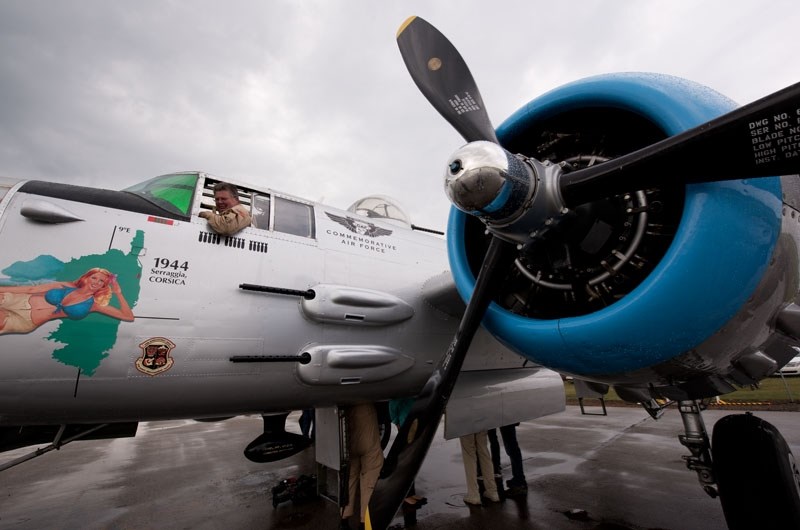Flying in the back of a B-25J bomber would not have been a comfortable experience.
There's the engines, for one, which drone like blimp-sized bees. Then there's the way the plane seems to tilt vertical in the turns and drop half a foot without warning in flight. Add cramped quarters, four other people, the stench of cordite and diesel, the clatter of brass shell casings on steel, the roar of four .50 calibre machine guns blazing out the side and tail, evasive manoeuvres and no complimentary peanuts, and you've got a thoroughly unpleasant Second World War flight.
But when Sherwood Park's Gerry Regehr got to ride in one of these old war-birds last Friday at Villeneuve Airport, he said it was like coming home again – he spent much of the 1950s behind the controls of them.
"I still know all the checklists," he said, and he still remembers where all the equipment was stored.
"This is a very nostalgic aircraft."
Regehr, 85, was one of a handful of Edmonton-area residents who got to ride in a restored B-25J Mitchell bomber that landed at Villeneuve Airport last week. The plane, owned by the Arizona Commemorative Air Force Museum, was in town to promote the Edmonton Airshow.
Airshow organizer Dean Heuman said the museum had hoped to have this plane at the airshow, but it had to come earlier due to scheduling conflicts.
"We know we have a lot of aviation fans here in Edmonton," he said, and this plane's visit served as a nice preview of the airshow.
"Plus, it's a fabulous airplane. It's really is quite beautiful."
Vintage war-bird
This visit was part of the museum's annual Flying Legends of Victory Tour, where pilots take real Second World War planes across North America and let people ride in them to teach them about history, said Ed Campbell, on-scene commander with the museum.
"If you look at the school curriculum in the U.S. right now, a lot of them aren't teaching anything before Vietnam," he said.
It's the museum's mission to promote aviation history so that the contributions of Second World War aircrews are not forgotten, he continued.
"The only way for us to do that is to take these flying museums around."
The B-25 was an agile medium bomber able to shoot its way to and from a target, Campbell said. Equipped with 12 machine guns and up to 3,000 pounds of bombs, it was particularly effective at strafing and exploding railway bridges.
The B-25 is best known as the plane used in the 1942 Doolittle Raid on Tokyo, Campbell said. This particular plane (dubbed "Maid in the Shade," as museum staffers rebuilt it under a lean-to attached to their hangar) didn't participate in that raid, but has had its bomb-bay doors signed by two pilots who did.
This bomber flew 15 combat missions in Italy and Yugoslavia in 1944, Campbell said. Post-war, it was used to bomb fire ants with pesticides before the museum started work on it in 1982. Now, after 27 years of restoration, it's one of only 34 B-25s in the world still flying.
Regehr said he spent some 1,700 hours flying B-25s for the air force out in Winnipeg. His bosses let him take the plane wherever he wanted on weekends for training, so he'd fly home to Edmonton to visit his future wife.
"It's very powerful," he said.
The whole plane shakes as the twin 14-cylinder engines cycle up, spitting streams of white dragon-smoke as they do. It's butter-smooth on takeoff and landing, but bucks hard enough on occasion in flight to nearly knock you off your feet.
Inside, the plane is snug, with just enough room to swing your elbows without hitting the walls – the side-gunners would have been back-to-back on occasion. You have to slither between the roof and the bomb-bay to reach the front and crawl through a toddler-sized tunnel to reach the nose, which Regehr visited.
"You have a very good view as there's no wing in the way," he said, noting that he got a good look at Rogers Place and the old City Centre Airport.
The bombardier managed two spring-stabilized machine guns while seated in the nose, Campbell said. Once the pilot locked in the speed and altitude, the bombardier used a control box to adjustment the plane's heading while looking down the Norden bombsight. Once he centred the target in the crosshairs, he'd hit a switch and drop the bombs.
Regehr said he had a great flight, adding that it was too bad they didn't give him a turn in the pilot's seat again.
"The popping of those engines – they just haven't changed at all," he said.
"A day to remember for me for sure."
The B-25J has now headed off to Springbrook, Alta. For more on it, visit www.azcaf.org/plane/b-25j-mitchell.




